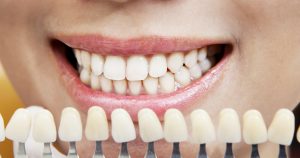Do you have bonded teeth and are curious how to whiten bonded teeth at home? Maybe you're getting dental bonding done soon, you just got it done, or you've had it for a while. Whatever your case may be, Dentaly.org wants to make sure you have all the facts before you try whitening bonded teeth.
In this article, we'll answer some common questions, including:
- What is dental bonding?
- How does bonding respond to color?
- Can you whiten bonded teeth?
- When should I whiten my bonded teeth?
- How can I whiten resin bonded teeth?
- How do you remove stains from stained bonded teeth?
By answering these questions, we hope to give you clarity on whitening bonded teeth.
In This Article
What is dental bonding?
According to the American Dental Association, “bonding is a process where the dentist attaches or ‘bonds' materials directly to your tooth in order to change the color and shape. The natural tooth enamel is then fused together with bonding materials such as resins to create a strong structure that still feels like your original tooth.”

Why would someone need to get teeth bonding?
There are a few issues that bonding can aesthetically help. These include:
- Diastema (gaps between teeth)
- Cracked or chipped teeth
- Discolored teeth
- Teeth that are crooked or misshapen
Teeth bonding is meant to even out the size, shape, or color of teeth, or cover any minor issues in someone's smile. Nobody would be able to tell if you had teeth bonding — only a dentist! Bonding is often used for fillings and veneers.
How does bonding respond to color?
Bonding resin can appear stained, but it will not appear white when attempting to brighten with tooth-whitening products. That's because natural teeth are porous and bonding is nonporous. On your natural teeth, stains form when the staining agents penetrate your teeth's pores. Similarly, whitening agents penetrate the surface of your teeth to whiten them.

Because of the nonporous nature of resin, whitening agents can't penetrate them. So your bonded teeth can look stained and discolored in certain areas due to the contrast with your natural teeth.
Composite bonding is made from a solution of inorganic filler particles, such as quartz or glass, bound together in a plastic matrix. Because of that, it will absorb stains into its actual material.
For example, if you drink a lot of staining beverages, like coffee or tea, they can penetrate the plastic and become a part of the bonding structure.
Can you whiten bonded teeth?
If you’re looking to maintain a bright smile, it’s essential to understand that the resin material used with dental bonding will stain over time, but it doesn’t respond to whitening treatments.
According to the National Center for Biotechnology Information, whitening agents will only reduce the strength of teeth bonding.
Therefore, whitening your teeth will create a situation where your natural teeth become a different shade than the bonding material. Lucky for you, there are certain things you can do to maintain those pearly whites!
When should I whiten my bonded teeth?
The best time to whiten your natural teeth is before you have a bonding procedure. That way, your teeth are at their whitest when your dental professional color-matches the bonding resin. Then, if you keep your teeth white with good oral care and touch-up treatments, your natural and bonded teeth will continue to match.

How to whiten resin bonded teeth
Even though whitening bonded teeth does not work with traditional whitening methods, you can try preventing stains and removing them when stains appear.
Tips for keeping your smile bright after dental bonding
There are specific steps you can take after getting dental bonding to help maintain a bright, beautiful smile for a long time:
- Stay on top of your oral hygiene – brush twice a day and floss once a day
- Avoid the consumption of staining foods and beverages – coffee, tea, colas, or red wine.
- Quit smoking
- Visit the dentist twice a year for regular dental cleanings
How to remove stains from bonded teeth
Depending on the severity of the stains, you have two options:
- A good polish from your dentist – If the stains look more like scratches, try getting a good polish from your dentist. The polishing could take the stains off and make your teeth shiny again!
- Replace the bonding – If your teeth still look glossy but darker, you may need to replace the stained resin with bonding resin that matches your new tooth color. This might be a good option if your bond is more than ten years old or has deteriorated for any reason.
Conclusion
Now that you know the answer to your burning question, “can bonded teeth be whitened?” and you've learned why bonded teeth cannot be whitened, try out the tips mentioned above to prevent and remove stains from your bonded teeth.
If brushing your teeth doesn't seem to be keeping your teeth bonding white, consult with your dentist for your next plan of action instead of attempting to whiten them on your own!
National Center for Biotechnology Information: Effect of whitening agents on dentin bonding. Consulted 14th November 2021.
Michael Weiss: Dental bonding staining. Consulted 14th November 2021.
ADA: Bonding. Consulted 14th November 2021.




